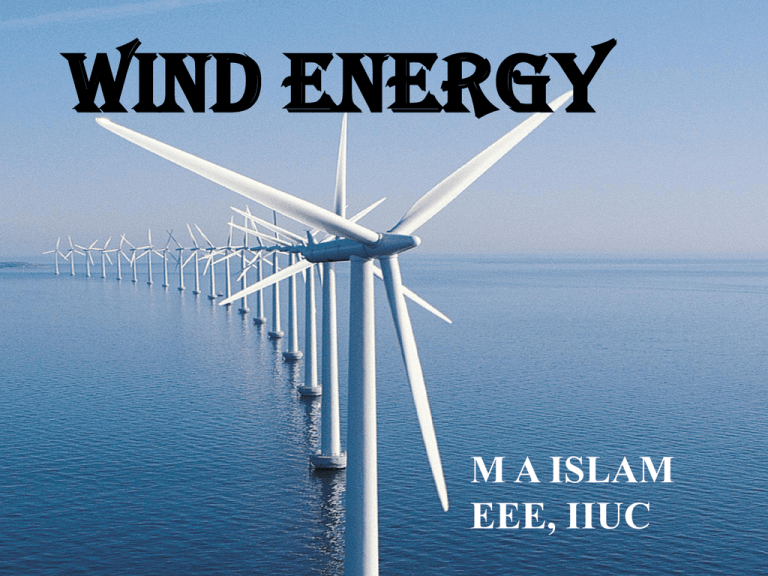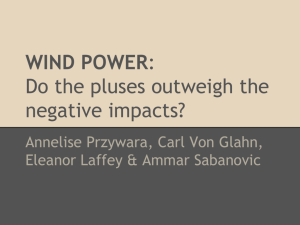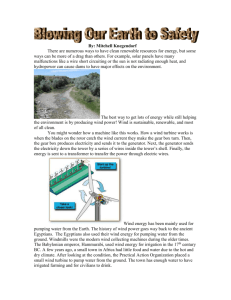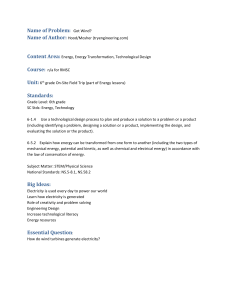CH 6_ M A Islam_WINDPOWER
advertisement

Wind energy M A ISLAM EEE, IIUC Wind in action: When wind strikes an object, it exerts a force in an attempt to move it out of the way. Some of the winds’ energy is transferred to the object, in this case the windmill, causing it to move. Wind Today!!! Windmills are used for pumping water from deep underground. Modern wind turbine is the result of design and material advances made during the 1980s and 1990s, which enabled wind turbines to become increasingly efficient. Today, wind turbines are size same as the traditional European windmill. It can generate 250 to 300 kilowatts of power- a nearly tenfold increase in efficiency. History of Wind usage: one of the earliest energy resources. Recorded in history, first to power boats and grind grain, later to pump water, press oil, saw lumber and make paper. Windmills were mentioned at the beginning of Islamic civilization (7th century). Windmills were developed in Persia and used paddles made of bundled reeds. Egyptians may have been the first to go up the Nile river around 4th century B.C, powered by wind. Ancient Chinese used vertical axis windmills to grind grain and pump water. Windmills were introduced to Europe by the crusaders around 1300 A.D *windmills used for pumping water. WIND POWER - What is it? • All renewable energy (except tidal and geothermal power), ultimately comes from the sun • The earth receives 1.74 x 1017 watts of power (per hour) from the sun • About one or 2 percent of this energy is converted to wind energy (which is about 50-100 times more than the energy converted to biomass by all plants on earth • Differential heating of the earth’s surface and atmosphere induces vertical and horizontal air currents that are affected by the earth’s rotation and contours of the land WIND. ~ e.g.: Land Sea Breeze Cycle • Winds are influenced by the ground surface at altitudes up to 100 meters. • Wind is slowed by the surface roughness and obstacles. • When dealing with wind energy, we are concerned with surface winds. • A wind turbine obtains its power input by converting the force of the wind into a torque (turning force) acting on the rotor blades. • The amount of energy which the wind transfers to the rotor depends on the density of the air, the rotor area, and the wind speed. • The kinetic energy of a moving body is proportional to its mass (or weight). The kinetic energy in the wind thus depends on the density of the air, i.e. its mass per unit of volume. In other words, the "heavier" the air, the more energy is received by the turbine. •at 15° Celsius air weighs about 1.225 kg per cubic meter, but the density decreases slightly with increasing humidity. A typical 600 kW wind turbine has a rotor diameter of 43-44 meters, i.e. a rotor area of some 1,500 square meters. The rotor area determines how much energy a wind turbine is able to harvest from the wind. Since the rotor area increases with the square of the rotor diameter, a turbine which is twice as large will receive 22 = 2 x 2 = four times as much energy. To be considered a good location for wind energy, an area needs to have average annual wind speeds of at least 12 miles per hour. Wind turbines convert the kinetic energy in the wind into mechanical power. This mechanical power can be used for specific tasks (such as grinding A wind turbine works the opposite of a fan. grainoforusing pumping water) or like a a fan, Instead electricity to make wind, wind turbines use can wind to make electricity. generator convert this The wind turns the blades, which spin a shaft, which connects power into electricity. The energy in the wind turns two or three to amechanical generator and makes electricity. propeller-like blades around a rotor. The rotor is connected to the main shaft, which spins a generator to create electricity. Wind turbines are mounted on a tower to capture the most energy. At 100 feet (30 meters) or more above ground, they can take advantage of faster and less turbulent wind. Wind Turbine Types VERTICAL AXIS TURBINE . . Modern wind turbines fall into two basic groups; the horizontal-axis variety, like the traditional farm windmills used for pumping water, and the vertical-axis design, like the eggbeater-style Darrieus model, named after its French inventor. Most large modern wind turbines are horizontal-axis turbines. Turbine Components A Wind Turbine Pitch A Wind Turbine Rotor Blades Generator Tower Specific components Description Wind turbine 2. Is the rotor. The rotor provides the blades to rotate. 4. This is brake. It’s very important to have a brake in a wind turbine, if something is wrong or it is going to fast. Then it will brake and stop the wind turbine. 5. is a low-speed shaft, it goes into a big cog wheel and this goes into a smaller cog wheel. The small cog wheel rotates faster than the big cog wheel. 7. This is the generator. It’s almost like a generator in a car. 13. It’s a yaw draw, it makes the wind turbine rotate in the wind direction. 15. Is the tower. The entrance is placed in the bottom of the tower . blade or rotor, which converts the energy in the wind to rotational shaft energy; a drive train, usually including a gearbox and a generator; a tower that supports the rotor and drive train other equipment, including controls, electrical cables, ground support equipment, and interconnection equipment. Wind Turbine Size and Power Ratings Wind turbines are available in a variety of sizes, and therefore power ratings. The largest machine has blades that span more than the length of a football field, stands 20 building stories high, and produces enough electricity to power 1,400 homes. . A small home-sized wind machine has rotors between 8 and 25 feet in diameter and stands upwards of 30 feet and can supply the power needs of an all-electric home or small business. Utility-scale turbines range in size from 50 to 750 kilowatts. Single small turbines, below 50 kilowatts, are used for homes, telecommunications dishes, or water pumping. How the does a wind turbine works? Wind turbines operate on a simple principle: The energy in the wind turns the propeller-like blades around a rotor. The pitch of the blades makes optimum use of the wind direction. The rotor is connected to the main drive shaft, which spins a generator to create electricity. Wind turbines are mounted on a tower to capture the most energy. At 30 metres or more above ground, they can take advantage of faster and less turbulent wind. Wind turbines can be used to produce electricity for a single home or building, or they can be connected to an electricity grid for more widespread electricity distribution. Advantages and Disadvantages??? Advantages: No pollution. Lowest prices renewable resources Don’t produce atmospheric emissions Disadvantages: Depending on how energetic a wind site is, the wind that cause acid rainsfarm and may or may not be cost competitive. green house effects. Wind energy cannot be stored (unless batteries are used) Good wind sites are often located in remote locations Wind resource development may compete with other uses for the land and those alternative uses may be more highly valued than electricity generation. sometimes birds have been killed by flying into the rotors Jaisalmer wind farm [The 2 largest off shore wind farm in the world] Onshore or offshore? Onshore advantages • A regular onshore turbine last for around 20 years • Normally it takes about 2-3 months before the wind turbine has paid itself back. This also includes the energy, which were used to produce, install, maintain and remove the wind turbine. • Cheaper foundation • Cheaper integration with electrical-grid network Onshore disadvantages • Wind turbines are noisy • Each one can generate the same level of noise as a family car travelling 70 mph • Some people thinks that the large towers of wind turbines destroys the view of the landscape Onshore or offshore? Offshore advantages Offshore disadvantages • A offshore wind turbine is • More expensive to built stronger than a onshore • More difficult to turbine. It lasts around maintain and access 25-30 years, and produces about 50 % more energy than a onshore turbine. • When a strong wind blows, it produces around 3-5 MW per hour. • Higher and more constant wind speed London Array [Worlds largest on shore wind farm] General advantages • Wind energy is friendly to the surrounding environment, as no fossil fuels are burnt to generate electricity from wind energy • Wind turbines requires less space than average power stations. • When combined with solar electricity, this energy source is great for developed and developing countries to provide a steady, reliable supply of electricity General advantages • The wind blows day and night, which allows windmills to produce electricity throughout the day. (Faster during the day) • Energy output from a wind turbine will vary as the wind varies, although the most rapid variations will to some extent be compensated for by the inertia of the wind turbine rotor. • Wind energy is a domestic, renewable source of energy that generates no pollution and has little environmental impact. Up to 95 percent of land used for wind farms can also be used for other profitable activities including ranching, farming and forestry. • The decreasing cost of wind power and the growing interest in renewable energy sources should ensure that wind power will become a viable energy source in the United States and worldwide. General disadvantages • The main disadvantage regarding wind power is down to the winds unreliability factor. In many areas, the winds strength is not enough to support a wind turbine • Wind turbines generally produce allot less electricity than the average fossil fuelled power station, which means that multiple wind turbines are needed to make an impact. WINDMILL DESIGN • A Windmill captures wind energy and then uses a generator to convert it to electrical energy. • The design of a windmill is an integral part of how efficient it will be. • When designing a windmill, one must decide on the size of the turbine, and the size of the generator. LARGE TURBINES: • Able to deliver electricity at lower cost than smaller turbines, because foundation costs, planning costs, etc. are independent of size. • Well-suited for offshore wind plants. • In areas where it is difficult to find sites, one large turbine on a tall tower uses the wind extremely efficiently. SMALL TURBINES: Local electrical grids may not be able to handle the large electrical output from a large turbine, so smaller turbines may be more suitable. High costs for foundations for large turbines may not be economical in some areas. Landscape considerations Wind Turbines: Number of Blades Most common design is the three-bladed turbine. The most important reason is the stability of the turbine. A rotor with an odd number of rotor blades (and at least three blades) can be considered to be similar to a disc when calculating the dynamic properties of the machine. A rotor with an even number of blades will give stability problems for a machine with a stiff structure. The reason is that at the very moment when the uppermost blade bends backwards, because it gets the maximum power from the wind, the lowermost blade passes into the wind shade in front of the tower. • Wind power generators convert wind energy (mechanical energy) to electrical energy. • The generator is attached at one end to the wind turbine, which provides the mechanical energy. • At the other end, the generator is connected to the electrical grid. • The generator needs to have a cooling system to make sure there is no overheating. SMALL GENERATORS: Require less force to turn than a larger ones, but give much lower power output. Less efficient i.e.. If you fit a large wind turbine rotor with a small generator it will be producing electricity during many hours of the year, but it will capture only a small part of the energy content of the wind at high wind speeds. LARGE GENERATORS: Very efficient at high wind speeds, but unable to turn at low wind speeds. i.e.. If the generator has larger coils, and/or a stronger internal magnet, it will require more force (mechanical) to start in motion. o A windmill built so that it too severely interrupts the airflow through its cross section will reduce the effective wind velocity at its location and divert much of the airflow around itself, thus not extracting the maximum power from the wind. o At the other extreme, a windmill that intercepts a small fraction of the wind passing through its cross section will reduce the wind’s velocity by only a small amount, thus extracting only a small fraction of the power from the wind traversing the windmill disk. o Modern Windmills can attain an efficiency of about 60 % of the theoretical maximum. Orientation Turbines can be categorized into two overarching classes based on the orientation of the rotor Vertical Axis Horizontal Axis KidWind Project | www.kidwind.org Vertical Axis Turbines Disadvantages Advantages • Omnidirectional – Accepts wind from any angle • Components can be mounted at ground level – Ease of service – Lighter weight towers • Can theoretically use less materials to capture the same amount of windKidWind Project | • Rotors generally near ground where wind poorer • Centrifugal force stresses blades • Poor self-starting capabilities • Requires support at top of turbine rotor • Requires entire rotor to be removed to replace bearings • Overall poor performance and reliability • Have never been www.kidwind.org commercially successful P/m^2 = 6.1 x 10^-4 v^3 *The power in wind is proportional to the cubic wind speed ( v^3 ). WHY? ~ Kinetic energy of an air mass is proportional to v^2 ~ Amount of air mass moving past a given point is proportional to wind velocity (v) * An extra meter of tower will cost roughly 1,500 USD. A typical 600 kW turbine costs about $450,000. Installation costs are typically $125,000. Therefore, the total costs will be about $575,000. The average price for large, modern wind farms is around $1,000 per kilowatt electrical power installed. Modern wind turbines are designed to work for some 120,000 hours of operation throughout their design lifetime of 20 years. ( 13.7 years non-stop) Maintenance costs are about 1.5-2.0 percent of the original cost, per year. The U.S. currently has more than 1,600 MW of installed capacity and produces about 3 billion KWh of electricity each year. This is enough to meet the annual residential needs of 1 million people. More than 90 percent of this power is produced by three wind farms in California (Altamont Pass, Tehachapi and Palm Springs). Wind Turbines and the Landscape - Large turbines don’t turn as fast attract less attention - City dwellers “dwell” on the attention attracted by windmills Sound from Wind Turbines - Increasing tip speed less sound - The closest neighbor is usually 300 m experiences almost no noise Birds often collide with high voltage overhead lines, masts, poles, and windows of buildings. They are also killed by cars in traffic. However, birds are seldom bothered by wind turbines. The only known site with bird collision problems is located in the Altamont Pass in California. Danish Ministry of the Environment study revealed that power lines are a much greater danger to birds than the wind turbines. Some birds even nest on cages on Wind Towers.







